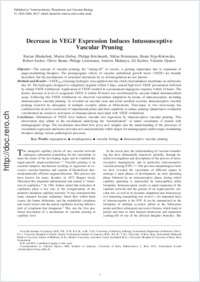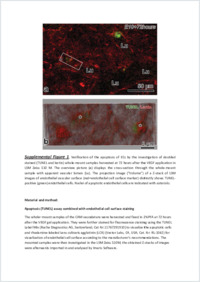Decrease in VEGF expression induces intussusceptive vascular pruning
- Hlushchuk, Ruslan Institute of Anatomy, University of Fribourg, Switzerland - Institute of Anatomy, University of Bern, Switzerland
- Ehrbar, Martin Department of Obstetrics, University Hospital of Zurich, Switzerland
- Reichmuth, Philipp Institute of Anatomy, University of Fribourg, Switzerland
- Heinimann, Niklas Institute of Anatomy, University of Fribourg, Switzerland
- Styp-Rekowska, Beata Institute of Anatomy, University of Fribourg, Switzerland - Institute of Anatomy, University of Bern, Switzerland
- Escher, Robert Inselspital, University Hospital of University of Bern, Switzerland
- Baum, Oliver Institute of Anatomy, University of Bern, Switzerland
- Lienemann, Philipp Department of Obstetrics, University Hospital of Zurich, Switzerland
- Makanya, Andrew N. Institute of Anatomy, University of Fribourg, Switzerland
- Keshet, Eli Hadassah Hebrew University School of Medicine, Hebrew University, Jerusalem, Israel
- Djonov, Valentin Institute of Anatomy, University of Fribourg, Switzerland - Institute of Anatomy, University of Bern, Switzerland
-
2011
Published in:
- Arteriosclerosis, Thrombosis, and Vascular Biology. - 2011, vol. 31, p. 2836-2844
English
Objective—The concept of vascular pruning, the “cuting-off” of vessels, is gaining importance due to expansion of angio-modulating therapies. The proangiogenic effects of vascular endothelial growth factor (VEGF) are broadly described, but the mechanisms of structural alterations by its downregulation are not known.Methods and Results—VEGF165-releasing hydrogels were applied onto the chick chorioallantoic membrane on embryonic day 10. The hydrogels, designed to completely degrade within 2 days, caused high-level VEGF presentation followed by abrupt VEGF withdrawal. Application of VEGF resulted in a pronounced angiogenic response within 24 hours. The drastic decrease in level of exogenous VEGF-A within 48 hours was corroborated by enzyme-linked immunosorbent assay. Following this VEGF withdrawal we observed vasculature adaptation by means of intussusception, including intussusceptive vascular pruning. As revealed on vascular casts and serial semithin sections, intussusceptive vascular pruning occurred by emergence of multiple eccentric pillars at bifurcations. Time-lapse in vivo microscopy has confirmed the de novo occurrence of transluminal pillars and their capability to induce pruning. Quantitative evaluation corroborated an extensive activation of intussusception associated with VEGF withdrawal.Conclusion—Diminution of VEGF level induces vascular tree regression by intussusceptive vascular pruning. This observation may allude to the mechanism underlying the “normalization” of tumor vasculature if treated with antiangiogenic drugs. The mechanism described here gives new insights into the understanding of the processes of vasculature regression and hence provides new and potentially viable targets for antiangiogenic and/or angio-modulating therapies during various pathological processes.
- Faculty
- Faculté des sciences et de médecine
- Department
- Département de Médecine
- Language
-
- English
- Classification
- Biological sciences
- License
- License undefined
- Identifiers
-
- RERO DOC 28383
- DOI 10.1161/ATVBAHA.111.231811
- Persistent URL
- https://folia.unifr.ch/unifr/documents/302317
Other files
Statistics
Document views: 75
File downloads:
- hlu_dei.pdf: 236
- hlu_dei_sm.pdf: 102

